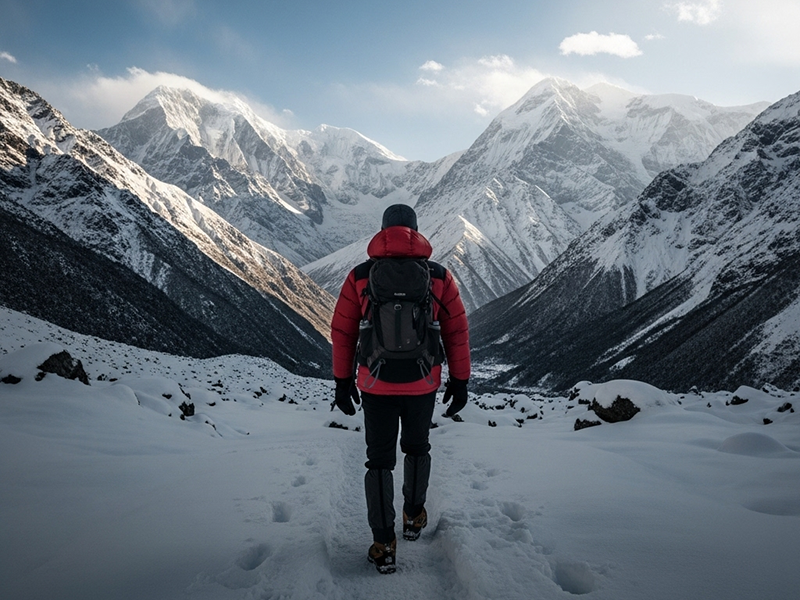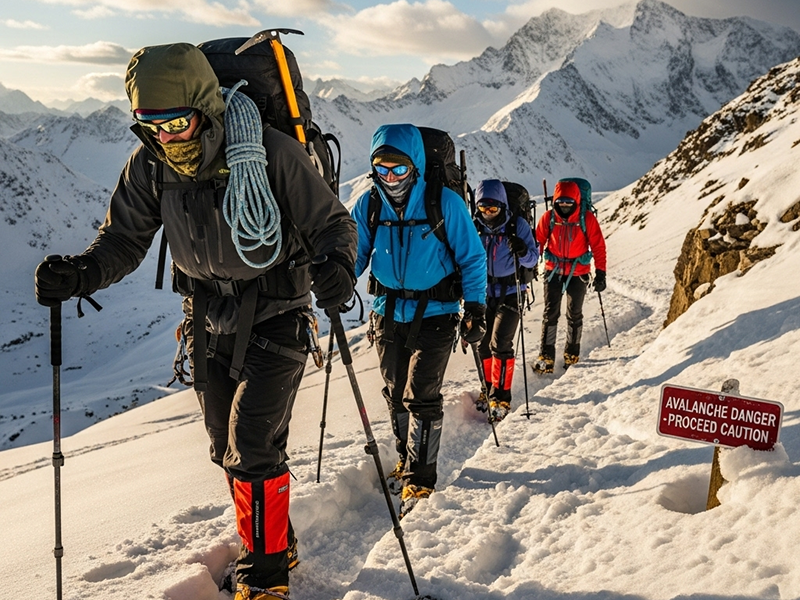The Annapurna Circuit is celebrated as one of the world’s most iconic trekking routes, renowned for its dramatic landscapes, diverse ecosystems, and rich cultural encounters. While spring and autumn attract the majority of trekkers with their mild weather and vibrant scenery, winter offers a distinct and compelling allure. Trekking the circuit during the colder months transforms the trail into a serene, snow-blanketed paradise, where fewer travelers mean solitude, crisp mountain air, and unobstructed panoramic views of the Annapurna massif.
Planning a winter trek in 2025 or 2026 requires careful preparation, as the season brings both enchanting beauty and formidable challenges. Snow-dusted peaks, frozen streams, and glittering valleys present a photographer’s dream, yet shorter daylight hours, icy trails, and sub-zero temperatures demand a strategic approach to gear, pacing, and safety.
This guide explores the pros and cons of winter trekking on the Annapurna Circuit, helping adventurers weigh the tranquil solitude and breathtaking vistas against the cold, challenging conditions and logistical considerations. By understanding what winter offers and what it requires – trekkers can make informed choices, ensuring a journey that is not only safe and manageable but also deeply rewarding. Whether you are a seasoned high-altitude trekker seeking a unique Himalayan experience or a thoughtful planner aiming to avoid the bustling peak seasons, this guide will illuminate everything you need to know about embracing the Annapurna Circuit in winter.
Pros of Winter Trekking the Annapurna Circuit

Trekking the Annapurna Circuit in winter offers a unique Himalayan experience, one that contrasts sharply with the busier spring and autumn seasons. Despite the chill and challenges, the season brings a collection of advantages that can make your journey truly unforgettable.
1. Solitude and Tranquility
Winter transforms the Annapurna Circuit into a peaceful sanctuary. With far fewer trekkers on the trail, you can immerse yourself in the serene rhythm of the mountains, enjoy quiet moments at teahouses, and relish the sense of isolation that allows for deeper reflection and connection with nature. This tranquil atmosphere is perfect for travelers seeking introspection or uninterrupted adventure.
2. Stunning Snow-Capped Landscapes
The winter months drape the Himalayas in a pristine blanket of snow, turning valleys, forests, and ridgelines into a dazzling winter wonderland. Frozen streams, snow-dusted peaks, and frosted rhododendron trees create scenes of extraordinary beauty, ideal for photography and memorable visual experiences that are simply unattainable in other seasons.
3. Clear Skies and Crisp Air
Winter brings exceptional clarity, with skies often unobstructed by monsoon clouds or haze. The crisp, invigorating air enhances visibility, allowing trekkers to enjoy panoramic vistas of the Annapurna massif, Dhaulagiri, and surrounding peaks in their full glory. Sunrise and sunset over snow-laden mountains are particularly striking during this time.
4. Off-Season Benefits
The quieter months also offer practical advantages. Accommodations and teahouses may provide discounted rates, and interactions with local communities are more personal and relaxed. Without the crowds, each encounter feels authentic, giving trekkers a richer cultural experience.
Cons of Winter Trekking the Annapurna Circuit

While winter unveils the Annapurna Circuit in a magical, snow-draped splendor, it also presents challenges that demand preparation, caution, and resilience. Understanding these drawbacks is crucial for planning a safe and enjoyable trek.
1. Cold Temperatures
Winter temperatures can be bitingly cold, particularly at higher altitudes. Daytime temperatures at lower elevations may remain comfortable around 5-15°C, but as you ascend toward Thorong La Pass or the upper valleys, temperatures can plunge below -15°C at night, with wind chill amplifying the cold. Proper insulated clothing, thermal layers, and high-quality sleeping gear are essential to withstand these frigid conditions.
2. Snow-Covered and Slippery Trails
Snow enhances the scenery but also adds complexity to navigation. Trails may become slippery, obscured, or partially blocked, increasing the risk of slips or missteps. Certain high passes or ridges may require microspikes, trekking poles, or even crampons, and only trekkers comfortable with winter trekking conditions should attempt these sections.
3. Limited Daylight Hours
Winter days are shorter, with daylight often fading by late afternoon. Trekkers must start early and pace their daily distances carefully to avoid being caught on icy trails after dark. This constraint can require adjustments to your itinerary or additional overnight stops.
4. Reduced Teahouse Availability
Not all accommodations operate during winter. Some higher-altitude teahouses close due to low tourist traffic, which can limit food options, hot showers, and shelter availability. Trekkers need to plan ahead, confirm bookings in advance, and carry contingency supplies to ensure comfort and safety.
Safety Considerations for Winter Trekking

Winter trekking on the Annapurna Circuit offers enchanting vistas and solitude, but it also demands heightened awareness and meticulous preparation. Safety should always take precedence.
1. Proper Gear and Clothing
- Use a layering system: moisture-wicking base layers, insulated mid-layers, and a windproof, waterproof outer shell.
- Include warm gloves, hats, and scarves to protect extremities from frostbite.
- Microspikes or crampons are essential for icy sections, while sturdy trekking boots ensure grip on slippery terrain.
2. Experienced Guides and Porters
- Winter trails can be less predictable and more hazardous; hiring knowledgeable guides enhances safety.
- Porters can reduce load, helping trekkers conserve energy for challenging stretches.
3. Monitoring Weather and Trail Conditions
- Mountain weather is highly volatile in winter. Check forecasts daily and be prepared to adjust your itinerary.
- Avoid trekking during blizzards, heavy snowfall, or high winds to minimize risk.
4. Altitude and Health Precautions
- Plan gradual acclimatization, particularly when crossing Thorong La Pass or trekking higher valleys.
- Stay hydrated and eat well to maintain stamina.
- Be vigilant for signs of altitude sickness, frostbite, or hypothermia.
Tips for Winter Trekking the Annapurna Circuit
1. Plan Your Itinerary Strategically
- Account for shorter daylight hours and allow extra time for slower progress on icy trails.
- Include flexible rest days to adapt to unexpected weather changes.
2. Pack Essentials Wisely
- Thermal clothing, down jackets, and insulated sleeping bags.
- Headlamp with extra batteries for early starts or late arrivals.
- High-energy snacks, water purification methods, and a compact first-aid kit.
3. Trekking Strategies
- Start days early to maximize daylight and avoid late-afternoon chills.
- Move deliberately on icy or snow-laden paths, using trekking poles for stability.
- Maintain a steady pace, especially at higher altitudes, to conserve energy and reduce risk.
4. Interact Mindfully with Local Communities
- Winter is off-season; many teahouses may be sparsely staffed.
- Respect local customs and schedules, and support small lodges to enhance your experience.
Reflect & Explore
Winter transforms the Annapurna Circuit into a realm of pristine beauty and tranquil solitude, offering a Himalayan experience that is as captivating as it is challenging. The snow-draped valleys, glittering peaks, and clear skies create vistas of unparalleled grandeur, allowing trekkers to witness the mountains in their purest and most intimate form.
However, this season is not without its demands. The biting cold, icy trails, shorter daylight hours, and limited teahouse availability require meticulous preparation, resilient spirit, and thoughtful planning. Winter trekking is ideally suited for adventurers who welcome both serenity and challenge, and who are equipped with the right clothing, gear, and knowledge to navigate the Himalayan elements safely.
By weighing the pros – solitude, breathtaking landscapes, and off-season advantages against the cons of harsh weather and logistical constraints, trekkers can make informed choices that ensure a safe, rewarding, and unforgettable journey. For 2025, 2026, and beyond, a winter trek on the Annapurna Circuit offers those prepared with courage and foresight a transformative Himalayan adventure, where every step through the glistening trails becomes a testament to both endurance and awe.
FAQ’s:
1. What is the best time for winter trekking on the Annapurna Circuit?
Winter trekking is ideal from December to February, offering snow-covered trails, peaceful trails, and clear skies. However, the cold and shorter daylight require proper preparation.
2. How cold does it get on the Annapurna Circuit in winter?
Daytime temperatures at lower elevations range from 5-15°C, while higher altitudes can drop below -15°C at night. Wind chill can make it feel even colder.
3. Are the trails safe during winter?
Trails can be icy and slippery, especially near high passes. Trekkers should use microspikes, trekking poles, and winter trekking experience to stay safe.
4. Are teahouses open in winter?
Most mid- and lower-elevation teahouses remain open, but some higher-altitude lodges may close. Pre-booking and confirming availability is recommended.
5. Can beginners trek the Annapurna Circuit in winter?
Winter trekking is more challenging and recommended for experienced trekkers. Beginners should consider guided treks or trekking during spring/autumn.
6. How short are daylight hours in winter?
Winter days offer about 8-9 hours of daylight, so early starts are crucial to complete trekking segments safely.
7. What essential gear is needed for winter trekking?
- Thermal layers, insulated jackets, waterproof outerwear
- Warm gloves, hats, scarves
- Microspikes or crampons, trekking poles
- Sturdy boots and headlamps
8. How should I acclimatize for high-altitude winter trekking?
Ascend gradually, rest at intermediate altitudes, hydrate, and monitor for altitude sickness symptoms. Avoid overexertion on icy trails.
9. Can families or children trek in winter?
Winter trekking is challenging for children due to cold, icy trails, and limited facilities. Families are better off trekking in spring or autumn.
10. What are the main benefits of winter trekking?
- Solitude and peaceful trails
- Stunning snow-covered landscapes
- Clear skies and panoramic mountain views
- Lower crowd levels and authentic local experiences
11. What are the main challenges of winter trekking?
- Extreme cold at high altitudes
- Snow-covered and slippery trails
- Shorter daylight hours
- Limited teahouse availability
12. How do I stay safe on icy or snowy trails?
- Move deliberately and slowly
- Use trekking poles and crampons where needed
- Follow experienced guides familiar with winter conditions
13. Is trekking insurance necessary for winter?
Yes, insurance covering high-altitude trekking, evacuation, and weather-related delays is strongly recommended.
14. How should I plan my daily distances?
Shorten daily trekking distances, start early, and allow extra time for slower progress on icy sections.
15. Can I expect clear skies for photography in winter?
Yes, winter often brings crystal-clear skies and crisp air, offering excellent visibility for photographing Annapurna, Dhaulagiri, and surrounding peaks.
16. How do I handle limited teahouse options at higher altitudes?
Plan your itinerary carefully, book lodges in advance, and carry extra snacks or essentials in case teahouses are closed.
17. Is winter trekking physically demanding?
Yes. Cold temperatures, snow, and slippery trails increase energy expenditure, making winter trekking more strenuous than spring or autumn.
18. Are there any off-season benefits?
- Fewer crowds
- Lower accommodation rates
- More intimate cultural experiences with local communities
19. How should I prepare my body for winter trekking?
- Train for endurance, strength, and stamina
- Practice walking on uneven or slippery terrain
- Focus on cold-weather acclimatization
20. Can I complete the full Annapurna Circuit in winter safely?
Yes, with proper planning, gear, guidance, and physical fitness. Safety precautions and flexibility in the itinerary are essential to ensure a successful trek.
